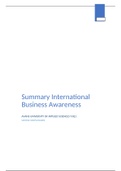Samenvatting
Summary International Business Awareness - Y3Q1
- Instelling
- Avans Hogeschool (Avans)
This summary includes all the chapters discussed during the course of International Business Awareness, namely chapter 12, 13, 14, 15, 11, 16 & 20 This course has been given at Avans University of Applied Sciences, Y3Q1
[Meer zien]





